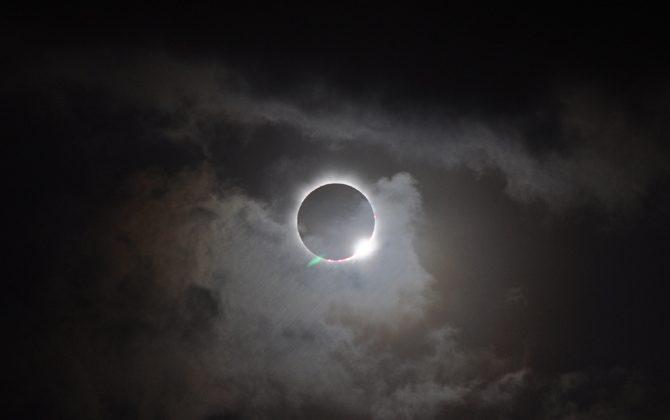Thousands of sightseers gathered in Western Australia’s red dirt as a total solar eclipse plunged day into darkness for one minute during the rare celestial event.
The total eclipse fell across the North West Cape in WA’s north at about 11.29 a.m. AWST (1.29 p.m. AEST) when the moon completely blocked the sun for a minute after temperatures dropped suddenly by 5C.
Perth schoolgirl Georgie Gibbs said it felt eerie.
“It’s surreal. It feels like a dream, actually,” she told AAP.
The eclipse lasted about three hours as the moon passed between the sun and earth as a partial then total eclipse, casting a 40km wide shadow over the World Heritage-listed Ningaloo reef region.
A bright solar corona that looks like a white halo visible to people in the path of totality, along with some stars and planets, was eagerly anticipated.
South Fremantle woman Julie Copson said the phenomenon left her skin tingling.
“I feel so emotional like I could cry, the colour changed and seeing the corona and sun flares,” Copson said.
“It was very strong, and the temperature dropped so much.”
As the partial eclipse started, Lois Polatnick from Chicago described her excitement.
“The moon is taking a bite out of the sun as we enter the shadow of the moon,” she said.
“We can see sun spots as we eagerly await totality.
“My favourite parts are the diamond ring and solar flares that become visible as we enter totality.”
Detroit man Shane Varrti, who has seen five eclipses, said he had started to plan his trip a year ago.
“It’s very exciting. All this effort has come to fruition,” he said.
Astrophysicist Melanie Johnston-Hollitt has always wanted to experience a total solar eclipse and has never been in the right place at the right time.
“To be able to see it from Australia makes it particularly special,” she said.
Cruise passengers took in the event on a ship off Exmouth, while eclipse goers set up along the roadside on the route to the main viewing point at Cape Range National Park.
Professor Johnston-Hollitt said the eclipse would help people understand the structure of the solar system.
“We are on a rock, the earth, being orbited by another rock, the moon, both of which are orbiting a star, the sun, in the vastness of space,” she said.
Thursday’s event, a hybrid eclipse that started as an annular eclipse in the Indian Ocean before changing into a total eclipse near Exmouth, is considered rare.
The Perth Observatory website crashed as people logged on to watch a live stream of the eclipse.
The observatory turned to Faecbook to provide an avenue to view stream the phenomenon.
“Thanks for visiting our website. You all crashed it,” the observatory said.
By the time the eclipse reached its peak, the website was back up and running, though the link to the live stream continued to be down.
Exmouth, with a population of about 2800, has swollen with thousands of visitors. A festival atmosphere has taken hold, with concerts and events at towns and cattle stations across the region.
Campsites have sprung up in front yards and on vacant blocks of land and the streets are bumper to bumper with 4WDs and camper vans.
Exmouth’s Earlybird Cafe had a line of customers out the door on Thursday morning.
Owner Mandy Brendel said the influx of visitors had kept her and three staff busy in the lead-up to the eclipse.
“It’s been absolutely amazing,” she said while making coffee.





